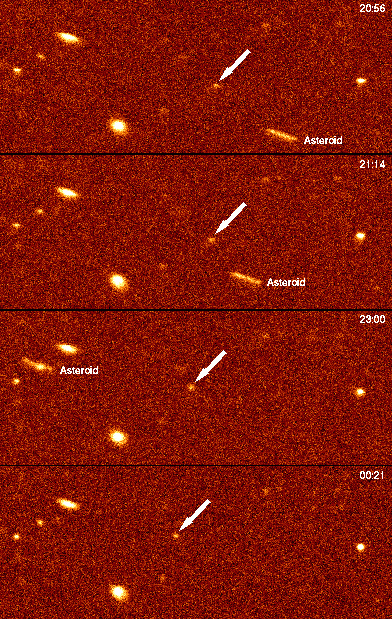Where the various comets that we see in our skies come from has long been a subject of high scientific interest. The Week 3 “Special Topics” presentation discussed how in the mid-20th Century the Dutch astronomer Jan Oort proposed the existence of the structure that we now call the “Oort Cloud” as being the source of the long-period comets. The Oort Cloud, however, does not adequately explain the large numbers of short-period comets, which tend to have low orbital inclinations, so these must come from another source. At right around the same time that Oort was proposing his ideas, an Irish engineer, Kenneth Edgeworth, proposed the existence of a disk-like structure of cometary bodies that began not too far beyond Neptune and extended out for perhaps a few hundred AU, and right around that same time the Dutch-American planetary scientist Gerard Kuiper independently proposed something similar. Kuiper made his proposal within the context of the overall formation of the solar system, and in his view, the bodies within this disk were “leftovers” from the formation of the planets.
Kuiper’s ideas essentially lay dormant for the next several decades. The idea of a population of objects in that part of the solar system was resurrected in the early 1980s by an astronomer from Uruguay, Julio Fernandez, and more vigorously later that decade by a trio of Canadian astronomers (Martin Duncan, Thomas Quinn, and Scott Tremaine), in an attempt to explain the origin of the low-inclination Jupiter-family comets. A series of mathematical calculations performed by the Canadian trio showed that this “Kuiper Belt” could account for the relatively large number of such objects that we see.
By that time observational technology and techniques had improved to the point where searches for such objects were practical. For the next few years, several astronomers engaged in search efforts for them, but initially, these were all unsuccessful. Finally, on August 30, 1992, two American astronomers, David Jewitt and Jane Luu, discovered an extremely faint (23rd magnitude) very slow-moving object – provisionally designated 1992 QB1 – in CCD images taken with the 2.2-meter telescope at Mauna Kea Observatory in Hawaii. Due to its slow motion, orbital calculations were problematical for a while, but eventually, it was established that 1992 QB1 is traveling in a near-circular low-inclination orbit at an average heliocentric distance of 44 AU and an orbital period of 290 years – right where the Kuiper Belt was predicted to be.
The question now was whether or not 1992 QB1 was a unique object, or if there might be additional objects located in that part of the solar system. That question began to be answered on March 28, 1993, when Jewitt and Luu discovered a second very faint, slow-moving object, 1993 FW, that has been found to be traveling in an orbit quite similar to that of 1992 QB1. In September 1993 Jewitt and Luu discovered two additional objects, 1993 RO and 1993 RP, and shortly afterward two more objects, 1993 SB and 1993 SC, were detected by a team of astronomers led by Iwan Williams using the 2.5-meter Isaac Newton Telescope at La Palma Observatory in the Canary Islands. Still more objects began to be discovered in 1994, and since then the discovery rate of these objects – sometimes called “Trans-Neptunian Objects,” or TNOs – has accelerated. Today over 2400 TNOs have been discovered, and several of the longest-known ones with well-established orbits have been numbered and in some cases named as well. 1992 QB1 is now formally known as (15760) Albion, the name referring to the “island-dwelling primordial man” in the creation mythology of the early 19th-Century British poet William Blake.
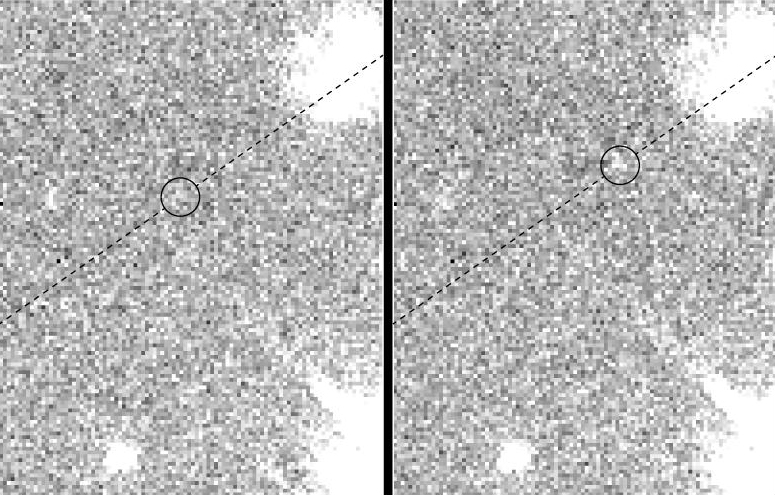
In physical terms, Albion has been estimated as being roughly 150 to 200 km in diameter, and a significant percentage of the other TNOs that have been discovered are also likely within this same size range. Current estimates are that are as many as 100,000 such objects 100 km in diameter or larger within the Kuiper Belt. Meanwhile, in August 1994 a team of astronomers led by Anita Cochran at the University of Texas took a series of exposures with the Hubble Space Telescope of a small region of sky in the constellation Taurus and appear to have detected between 30 to 50 extremely faint objects – approximately 28th magnitude – with motions consistent with location in the Kuiper Belt. While there has been some controversy associated with these results, at face value they nevertheless suggest that down to an approximate size of 10 km there may be as many as 100 million objects within the Kuiper Belt.
Several of the TNOs that have been discovered thus far, including some of the early known ones, have been found to be traveling in moderate-eccentricity orbits with average heliocentric distances of 39 AU and orbital periods close to 250 years – the same situation that exists with Pluto. These objects, including Pluto, are in what is called a “2:3 resonance” with Neptune, i.e., they orbit the sun twice for every three orbits that Neptune makes, and as a result, always remain in stable orbits far away from Neptune. Such objects are now often collectively referred to as “plutinos.” Several Kuiper Belt objects have been found that are traveling in a 1:2 resonance with Neptune, i.e., orbiting the sun once for every two orbits that Neptune makes, their average heliocentric distances being close to 48 AU and their orbital periods being approximately 330 years. A handful of TNOs have been found which appear to be orbiting in other orbital resonances with Neptune, for example, 3:4 and 3:5. On the other hand, a fairly large number of TNOs, including Albion, are not in any particular resonance with Neptune, and these objects are sometimes collectively referred to as “cubewanos” (a name taken from Albion’s provisional designation).
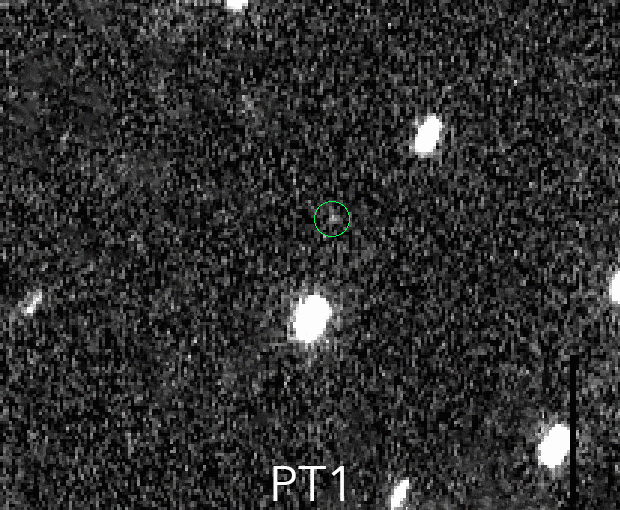
A non-trivial percentage of TNO’s, beginning with the first-known such object – (15874) 1996 TL66, discovered in October 1996 – are traveling in larger-eccentricity orbits more reminiscent of comets with orbital periods of several centuries (eccentricity of 0.58 and an orbital period of 750 years in this specific case). Such objects are part of what is now called the “scattered disk,” and due to their average large distances, they are at present only detectable when they are near perihelion. Somewhat over 200 scattered disk objects have been discovered thus far, but their true population is probably at least similar to that of the more “traditional” Kuiper Belt.
Due to their large distance and extreme faintness, it is difficult to perform much in the way of physical studies of TNOs, although this is helped to some extent by the fact that several dozen of them have been found to be accompanied by moons, thus allowing for determinations of their mass via application of Newton’s Law of Universal Gravitation and Kepler’s Third Law. (The topic of moons around these objects, and around “small bodies” in general, is the subject of next week’s “Special Topics” presentation.) What studies that have been conducted thus far suggest that there is a fairly wide range of composition ingredients among TNOs, although ices, including water ice, appear to be a fairly common component, as well as some forms of rocky material. A significant percentage of them, although not all, appear to be reddish in color, this most likely being due to the presence of tholins – organic molecules created by cosmic ray bombardment of ices, as described in a previous “Special Topics” presentation – on their surfaces. It is conceivable that some of the observed compositional differences can be explained by impacts that have “churned up” varying amounts of subsurface material, although this probably does not account for all the differences. In any event, although the structure of the Kuiper Belt is not quite consistent with what he proposed, Kuiper’s suggestion that the population of this region is made up of “leftovers” from the planet formation process appears to be valid.
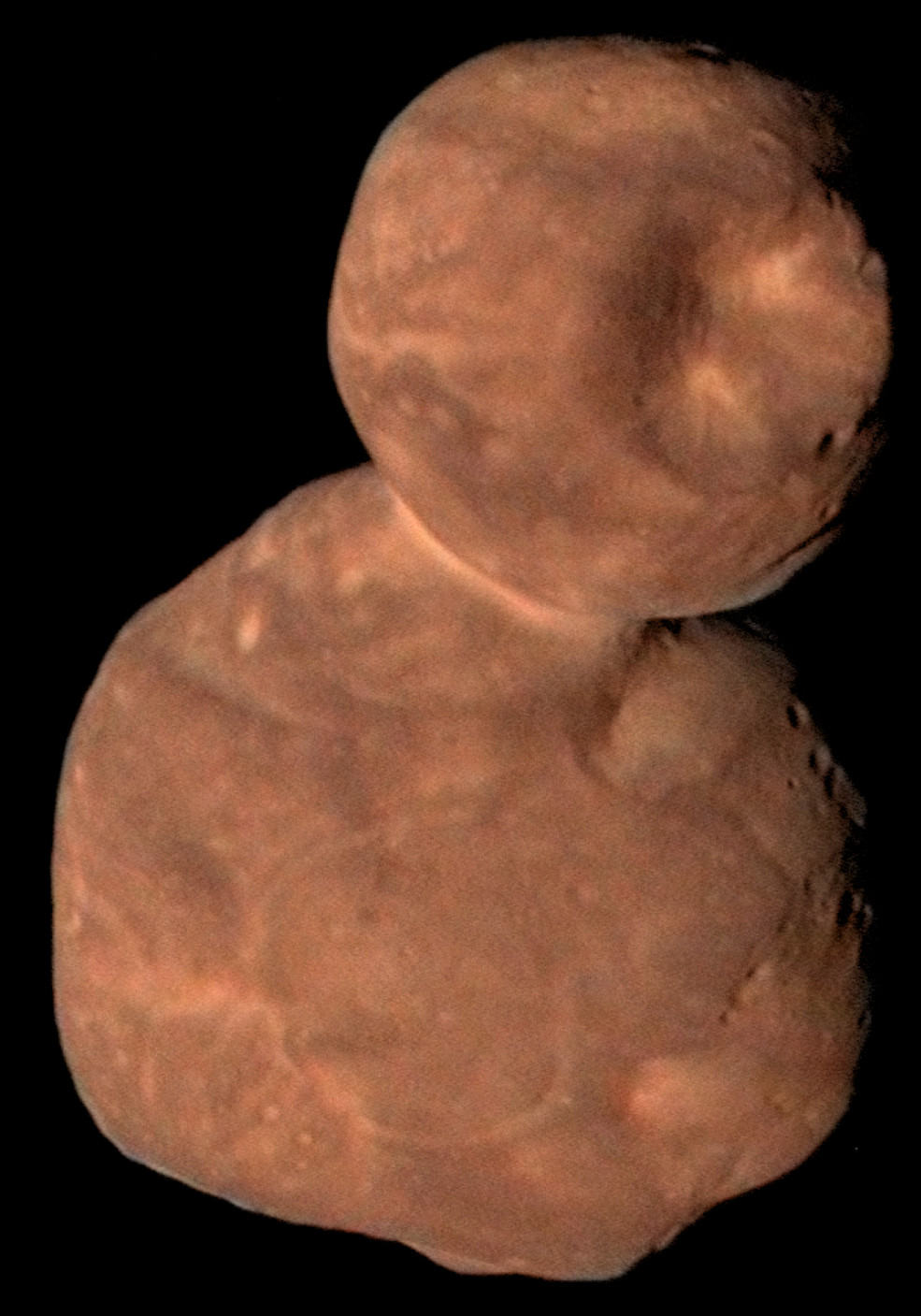
The one object that has been studied up close is (486958) Arrokoth. It was discovered on June 26, 2014, by a team of astronomers led by Marc Buie who were utilizing the Hubble Space Telescope to search for candidate Kuiper Belt objects that could be visited by NASA’s New Horizons mission following its flyby of Pluto in July 2015; it was one of three candidates so identified. Arrokoth orbits the sun in a near-circular orbit at an average heliocentric distance of 44.6 AU, and, with an apparent brightness of about 27th magnitude, is roughly 36 km by 10 km in its longest and shortest dimensions.
New Horizons passed 3500 km from Arrokoth on January 1, 2019. The images returned from New Horizons show it to be what is called a “contact binary” – among the objects discussed in next week’s “Special Topics” presentation – with a larger object, “Ultima,” and a smaller object “Thule” (these names coming from the nickname “Ultima Thule” originally given to this object), stuck together, with a ring of bright surface material around their junction. (One large apparent impact crater, nicknamed “Maryland,” is visible on “Thule.”) The overall surface color is quite reddish, indicating the presence of tholins, and analyses suggest an overall composition primarily of ices and other frozen volatiles. The download of data from the Arrokoth encounter has been ongoing ever since the event itself, and meanwhile, it is possible that New Horizons might be directed towards an encounter with an as-yet-unidentified more distant Kuiper Belt object later this decade.
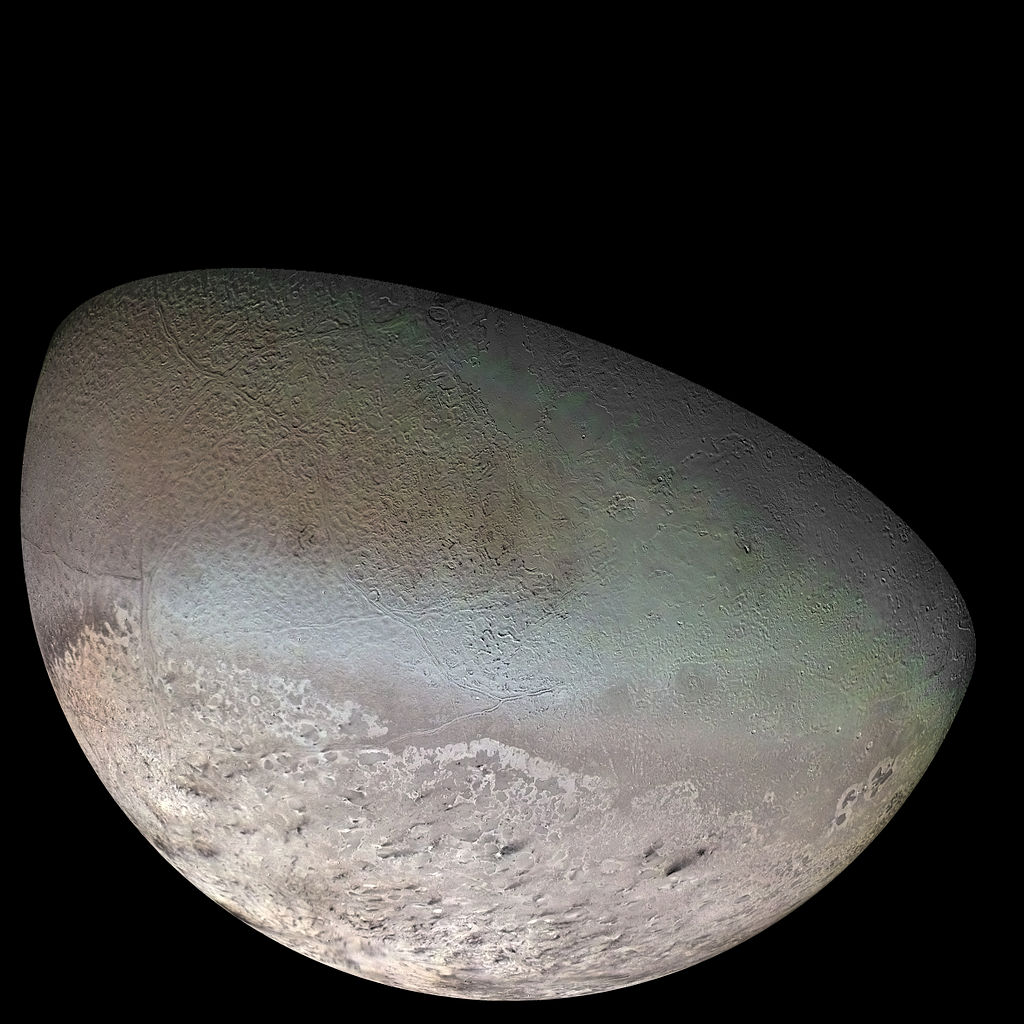
The various objects in the “traditional” Kuiper Belt, including those in both resonant and non-resonant orbits, appear to be gravitationally stable, and thus perhaps are not significant contributors to the population of short-period comets in the inner solar system. Rather, it is the scattered disk objects that are the most likely source of these objects, with a steady progression of scattered disk objects to centaurs – discussed in a previous “Special Topics” presentation – to short-period comets. As for how the scattered disk objects got there in the first place, gravitational scattering by the larger planets during the early days of the solar system, including Neptune which appears to have been located farther from the sun during that era than it is now, is most likely responsible. Incidentally, it seems likely that Neptune’s large moon Triton, which orbits in a near-circular but somewhat inclined retrograde orbit, is a “captured” Kuiper Belt object.
Initially, most of the discovered TNOs were roughly the same size as Albion. However, in November 2000 Robert McMillan with the Spacewatch program in Arizona discovered the TNO now known as (20000) Varuna, which has an approximate diameter of 680 km, approximately ¾ the diameter of (1) Ceres. Then, in June 2002 Chad Trujillo and Michael Brown at Palomar Observatory in California discovered the TNO now known as (50000) Quaoar, which has an approximate diameter of 1100 km, roughly half that of Pluto. Since Pluto is in this same region of the solar system it seemed entirely conceivable that, at some point, Kuiper Belt objects might be discovered that are as large as, or conceivably even larger than, Pluto.
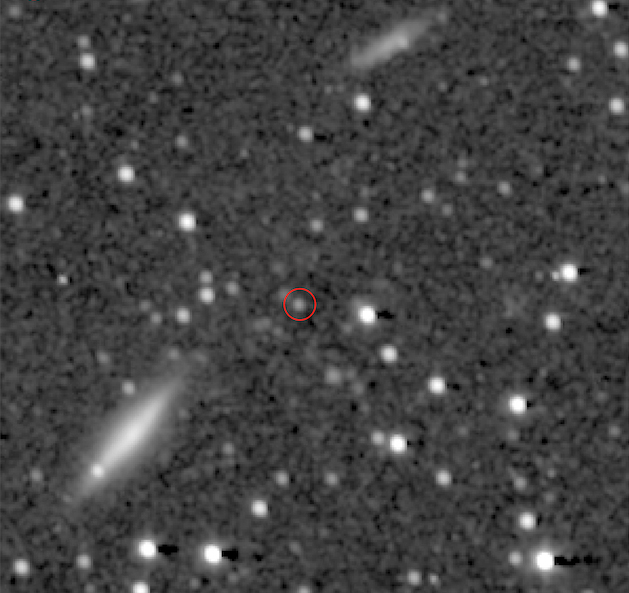
This finally happened in 2005, when on July 29, Brown and his team announced the discovery of three approximate Pluto-sized Kuiper Belt objects, now known as (136108) Haumea, (136199) Eris, and (136472) Makemake. (Haumea and Eris had actually been discovered in 2003 but not yet announced, and Haumea was also independently discovered by a Spanish team led by Jose Ortiz. All three of these objects have at least one moon – Haumea has at least two and also an accompanying ring – and Haumea is rather strongly ellipsoidal in shape due to a rapid rotation.) Eris – which is a scattered disk object with an eccentricity of 0.44, an inclination of 44 degrees, an orbital period of 558 years and a present heliocentric distance of 96.0 AU with a perihelion passage at a distance of 38 AU taking place in 2257 – was originally thought to be slightly larger than Pluto, but with a rough measured diameter of 2326 km (as opposed to 2377 km for Pluto as determined by New Horizons) is now known to be slightly smaller, although the presence of its moon Dysnomia allows its mass to be determined as being 27% more than that of Pluto.
The discovery of these objects, Eris in particular, brought matters to a head as far as what is and what is not a “planet.” If Pluto is a “planet” than Eris should also be one, and since Haumea and Makemake are only slightly smaller, valid arguments can be made for including them as “planets” as well. However, there appears to be a gradual continuum all the way down, and where to draw the line between what is and what is not a “planet” quickly becomes a completely arbitrary exercise. It was considerations like these that led the International Astronomical Union to adopt its formal designation of “planet” at its General Assembly in Prague, Czech Republic, in August 2006 and to create a new category of object, “dwarf planet,” that at present includes Pluto, Eris, Haumea, and Makemake, as well as the main-belt asteroid (1) Ceres. As I argued in Pluto’s “Special Topics” presentation, whatever arbitrary label we might append to any object does not in any way detract from its importance, for these are all unique and exciting worlds, worthy of study in their own right. Such a viewpoint also indicates that Pluto was the first-known Kuiper Belt object (although obviously unrecognized as such at the time) – that is, unless one also wishes to include Triton (discovered by British astronomer William Lassell in 1846, and 14% larger than Pluto) as a “captured” Kuiper Belt object.
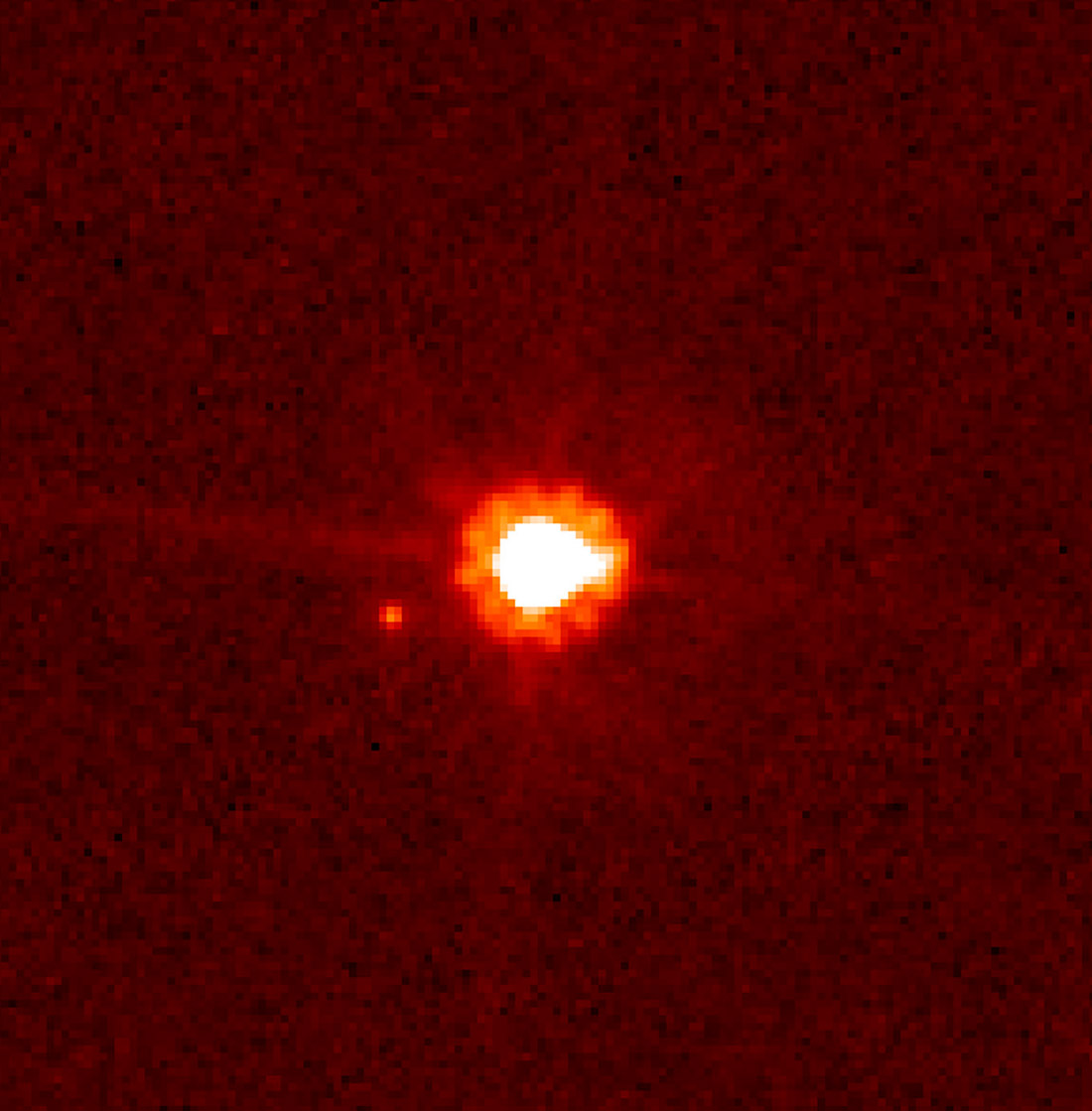
It is entirely possible that we will discover additional large worlds among the TNOs as our search efforts continue. Meanwhile, the Kuiper Belt and the scattered disk are not the final word on the population of objects in the solar system beyond Neptune; beginning with the discovery of the object now known as (90377) Sedna in 2003 we now know that there are objects in the far outer solar system as well. These objects are discussed in a future “Special Topics” presentation.
While we now know that there is no such thing as a “typical” planetary system, it at least seems likely that the processes by which planetary systems form essentially remain the same from one system to another. Thus, structures akin to the Kuiper Belt would be expected to exist around other stars, and, indeed, excess infrared radiation indicative of dust, as well as debris disks, have been detected around various stars for the past few decades. Some of these are located at distances from their parent stars that are comparable to our solar system’s Kuiper Belt and may well represent a similar type of structure. These are discussed in a future “Special Topics” presentation.
More from Week 36:
This Week in History Comet of the Week Free PDF Download Glossary
Ice and Stone 2020 Home Page
